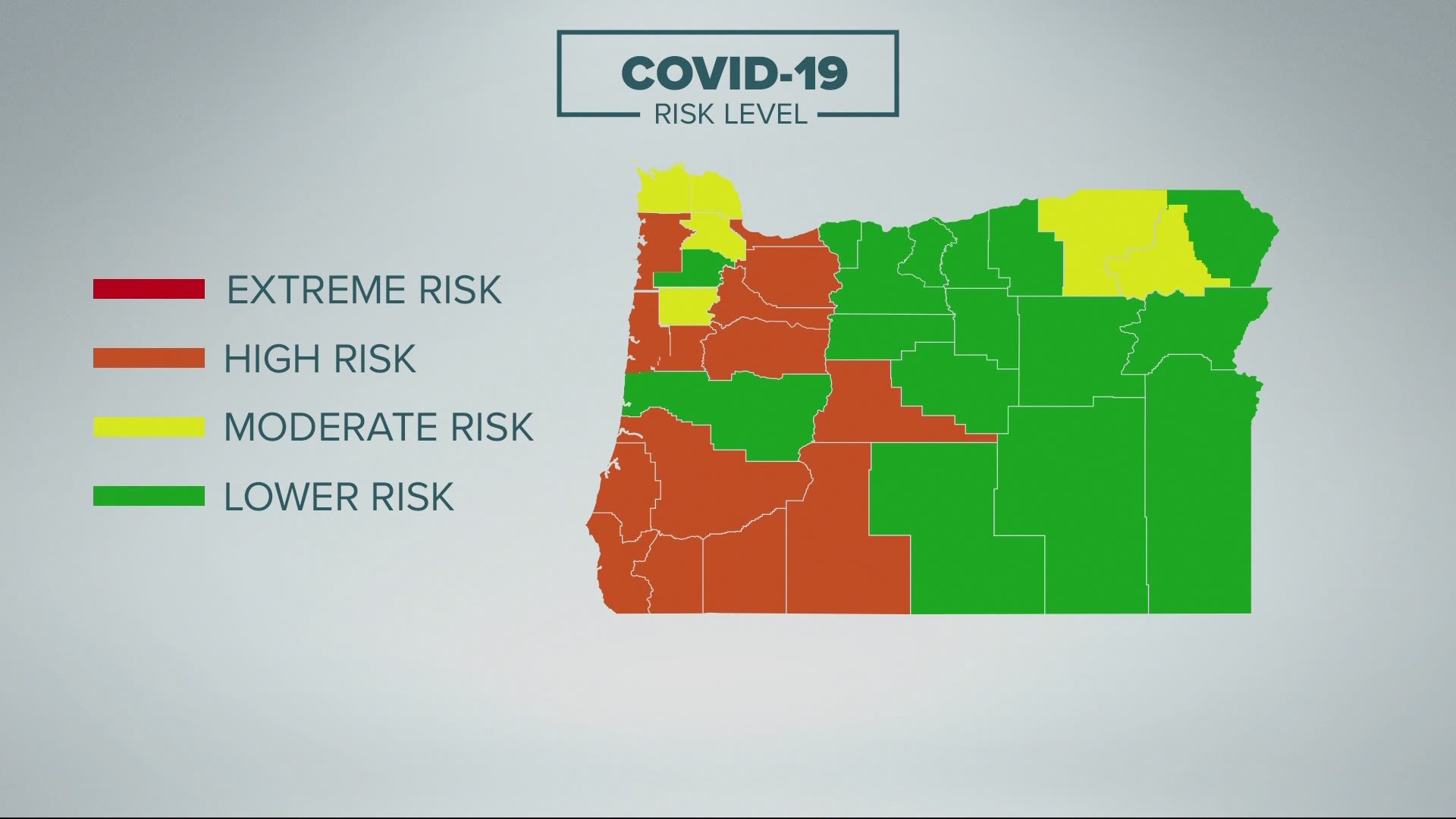PORTLAND, Ore — Six Oregon counties, including Multnomah and Clackamas, will move from moderate risk to high risk when the state’s new COVID-19 risk levels begin on Friday, April 9, Oregon Gov. Kate Brown announced Tuesday.
The move means fewer people will be allowed at indoor businesses such as restaurants and gyms.
There will be 14 counties in the high risk level, six at moderate risk and 16 at lower risk when the new levels take effect. Zero counties currently qualify for extreme risk.
- Read the full list of rules for each risk category
“We are at a critical moment in this pandemic as we face more contagious variants of COVID-19 taking hold in our communities,” said Brown. “Now more than ever it’s imperative that we all continue wearing masks, maintain physical distance, stay home when sick and get the vaccine when it’s available to you.”
Gov. Brown earlier on Tuesday had announced another change to Oregon's vaccine timeline: All Oregonians 16 and older will be eligible for vaccination on April 19.
Under Oregon’s latest framework for coronavirus-related restrictions, counties are placed into four risk level categories: extreme risk, high risk, moderate risk and lower risk. The extreme risk designation comes with the strictest regulations while the lower risk category comes with the least-restrictive rules. The Oregon Health Authority reassigns risk level designations to counties every two weeks, based on the latest data on COVID-19 spread.
Here’s the full list of county risk levels. Counties will remain at these risk levels from April 9 to April 22.
Extreme Risk (zero counties)
High Risk (14 counties)
- Benton
- Clackamas (Moved from Moderate)
- Coos (Moved from Extreme)
- Curry (Moved from Extreme)
- Deschutes (Moved from Moderate)
- Douglas
- Jackson
- Josephine
- Klamath (Moved from Moderate)
- Lincoln
- Linn (Moved from Moderate)
- Marion
- Multnomah (Moved from Moderate)
- Tillamook (Moved from Moderate)
Moderate Risk (6 counties)
- Clatsop
- Columbia
- Polk
- Umatilla (Moved from High)
- Union
- Washington
Lower Risk (16 counties)
- Baker
- Crook
- Gilliam
- Grant (Moved from Moderate)
- Harney
- Hood River
- Jefferson
- Lake
- Lane
- Malheur (Moved from Moderate)
- Morrow
- Sherman
- Wallowa
- Wasco
- Wheeler
- Yamhill
This week, Oregon added a statewide hospitalization metric for moving to extreme risk. "As vaccine distribution increases, case counts and percent positivity will not be adequate indicators on their own for measuring the threat COVID-19 poses to public health," said a news release from the governor's office.
In order for counties to move to extreme risk, they must meet the county metrics for case rates and percent positivity, plus a new statewide metric: COVID-19 positive patients occupying 300 hospital beds or more, and a 15% increase in the seven-day average over the past week.
Five counties are in a two-week caution period because they moved down in risk level during the previous two-week period but saw their COVID numbers rise in the latest two-week period.
- Baker County qualifies for extreme risk but is given a two-week caution period at lower risk because it moved down from moderate risk in the last movement period.
- Columbia County qualifies for extreme risk but is given a two-week caution period at moderate risk because it moved down from high rsk in the last movement period.
- Lane County qualifies for moderate risk but is given a two-week caution period at lower risk because it moved down from moderate risk in the last movement period.
- Polk County qualifies for high risk but is given a two-week caution period at moderate risk because it moved down from high risk in the last movement period.
- Yamhill County qualifies for moderate risk but is given a two-week caution period at lower risk because it moved down from moderate risk in the last movement period.
The caution period allows businesses to avoid abrupt closures and major changes in how they do business. If case numbers don’t improve in the next two weeks, however, the county will move backward.
Multnomah is one of the counties slipping back into the high risk category from moderate risk. County health officer Dr. Jennifer Vines attributes that to an upward trend of cases. The county surpassed the threshold of 100 cases per 100,000 people, which the state considers "substantial spread" of COVID-19.
It's a blow for businesses, like gyms, that were hoping to stay in the moderate-risk category for longer.
"As much as I’m worried, certainly for public health and the health of individuals, I dreaded this back and forth for businesses, because I know how hard it is for them; this yo-yo effect of moving in and out of categories," Dr. Vines said. "So, this is the state’s framework, it’s the framework we have for now. We have to ask businesses to comply and recognize that this is really to push down the spread in our count which is, most often, the highest risk from those types of indoor activities where you can’t readily wear a face covering or can’t really fully distance."
Here's a look at which metrics determine the risk level for each county:

